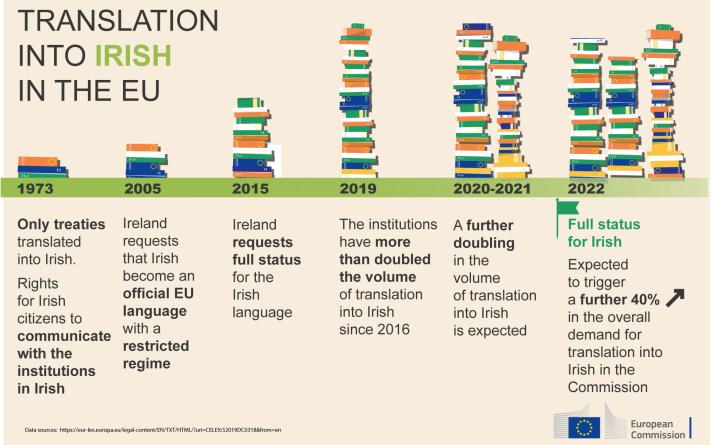When Ireland joined the European Communities (EC) in 1973, Irish became an official language of the EC, but with ‘Treaty status’ rather than full working language status. In practice, this meant that the Irish language versions of the Treaties were made available, and that EU citizens had the right to correspond with the EU institutions in Irish and receive an answer in Irish. However, the institutions were under no obligation to provide any additional materials in Irish (although efforts were always made by the European Commission’s Representation in Ireland, for example).
The status of the Irish language changed in 2007, when it became a working language, albeit with a limited status, meaning that initially, only a small share of documents were translated into Irish.
A. Translation into Irish in the EU: the volume of documents made available in Irish more than doubled between 2016 and mid-2019. This covers legislation, content for the web, and political, communication, consultation and reporting material.
B. Recruitment: The number of Irish-language staff in the EU institutions’ language services rose from 58 to 102 between the end of 2015 and mid-2019. Although it remains a challenge to meet the staffing targets for permanent staff, the EU has taken a flexible approach by recruiting and training temporary staff. Four open competitions (EPSO) were organised for permanent staff and 14 selection procedures for temporary staff.
C. External contractors: to complement the capacity of internal Irish-language staff, the EU institutions organised four calls for tenders for freelance translation services, one call for tenders for proofreading services and three accreditation tests for freelance interpreters.
D. Irish language resources: the EU and Ireland have joined forces to build up the Irish language resources available. A new English Irish neural machine translation engine was built in 2018. Irish-language content in the IATE terminology base and in Euramis, the inter institutional translation memory bank, continued to grow. The EU and Ireland also took a joint initiative to work on an Irish version of the body of EU law; 4,700 pages out of the 11,000 pages identified as key pieces of EU legislation were translated.
Careers with Irish
Information on careers for Irish language speakers in the EU institutions is available here.


